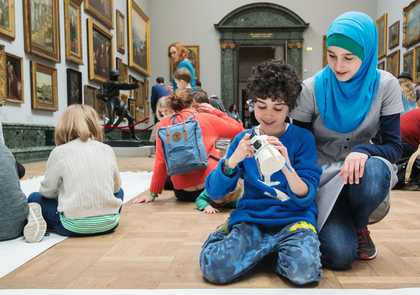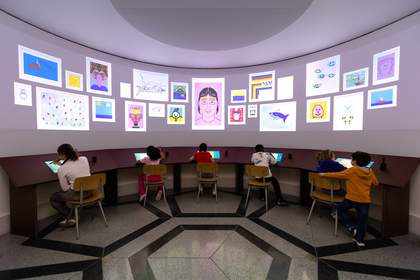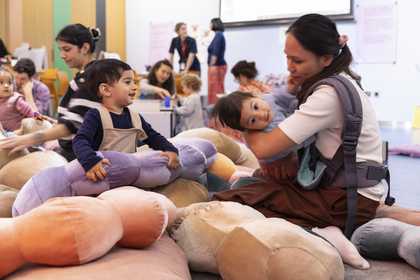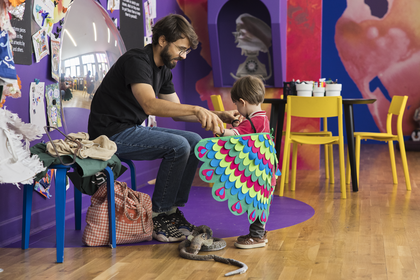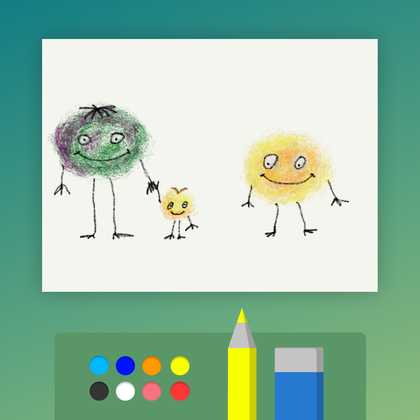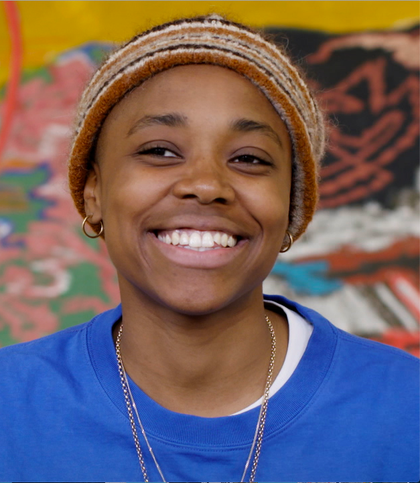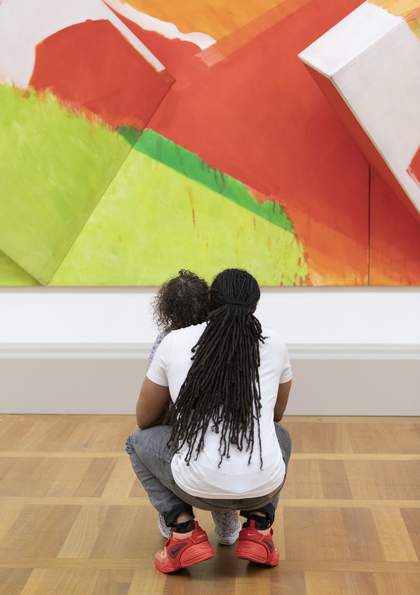
Photo © Tate (Jai Monaghan)
Where do we start?
When you visit Tate Britain you can learn about the story of British art from 500 years ago to the present. Have a go at finding these great artworks on your trip, and see what else you discover along the way. These are starting points to help you plan your visit as a family. Have fun and share your favourites with us on social media using #TateKids.
For more information about where to eat, drink and relax while you're here, read our top tips for visiting Tate Britain as a Family. Download our map [851 kb] to help find your way.
1. See double
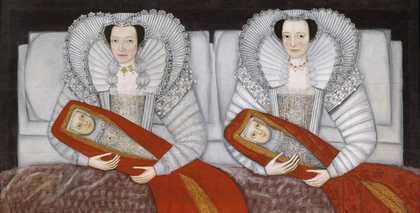
Unknown artist, Britain
The Cholmondeley Ladies (c.1600–10)
Tate
Where is it? Main Floor, Room 1 Historic and Modern British Art: Exiles and Dynasties: 1545–1640
This is a painting by an unknown artist, painted over 400 years ago. Look closely at the two women in the painting. They are sitting up in bed, fully dressed. When you first see the painting, you might think the pair of women and the pair of babies look the same.
What differences can you find between them? Look closely at their eyes, clothes and jewellery.
Do you think the Cholmondeley ladies were pleased with their portrait? Have a go at colouring them in.
2. Change the rules
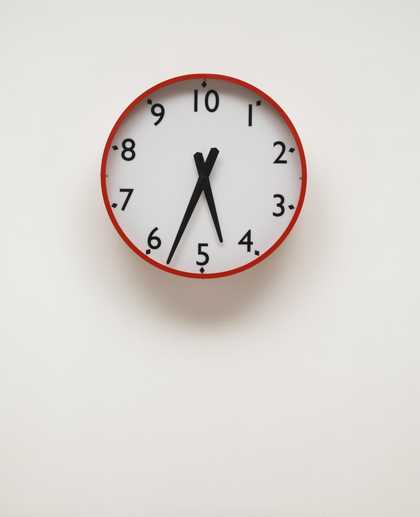
Ruth Ewan
We could have been anything that we wanted to be (red version) (2011)
Tate
Where is it? Room 6, Main Floor Revolution and Reform
Take a good look around the room. What different types of artworks do you notice?
Look up. What’s different about the large, wall-hung clock displayed high up above one of the entrances to the space?
Ruth Ewan is an artist interested in revolution and radical ideas (especially those that have been overlooked or forgotten).
Ewan changed this clock to have ten hours instead of twelve, and each hour into 100 minutes, each minute into 100 seconds. Ewan is making reference to an attempt by the newly reformed Republic of France in the 1790s to change the way time was measured following the overthrow of the French monarchy.
Does this artwork make you think differently about time, or about power and control?
See the timeline on the wall for more information about the French Revolution or read more about the work.
3. Self Portrait
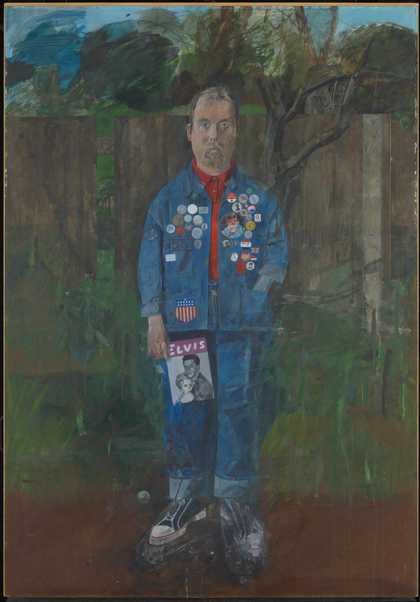
Peter Blake
Self-Portrait with Badges (1961)
Tate
Where is it? Room 19, Main Floor, Modern and Contemporary British Art: In Full Colour
Meet Peter Blake. Do you like his badges?
There are some clues in this self-portrait that tell us about Peter Blake. Which pop star do you think he likes?
Peter Blake is best known as one of the first pop artists in Britain. In the 1950s he was one of a group of young artists who made paintings and sculptures about popular culture (or "pop" culture). They painted things they liked such as films, comic books and pop music.
What things would you put in a portrait about you? Why not give it a try?
Learn more about Peter Blake on Tate Kids.
4. Take a seat
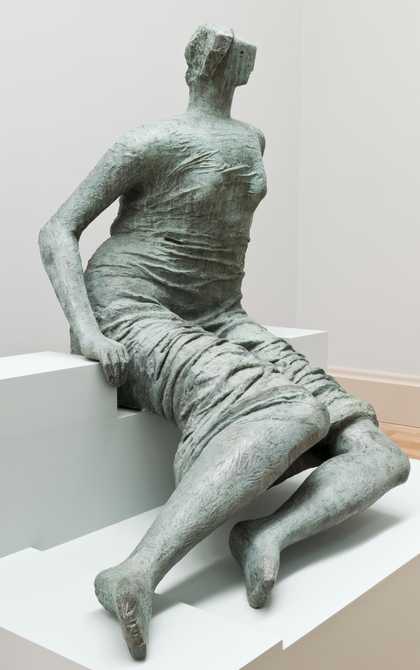
Henry Moore OM, CH
Draped Seated Woman (1957–8, cast c.1958–63)
Lent from a private collection 1989
© The Henry Moore Foundation. All Rights Reserved. Private collection
Where is it? Room 23, Main Floor, Modern and Contemporary British Art: Francis Bacon and Henry Moore
Walk right around this sculpture, look through any gaps and find out how it looks from different angles, far away and up close. What do you notice?
Stand back and take a good look. How would you describe this person? Can you imagine where they might be sitting and what they're looking at?
There are copies of this sculpture in public spaces in East London and Wuppertal, Germany. Do you think sculptures like these should be outside, or are they better off being looked after in galleries like Tate Britain?
5. Feel Colour
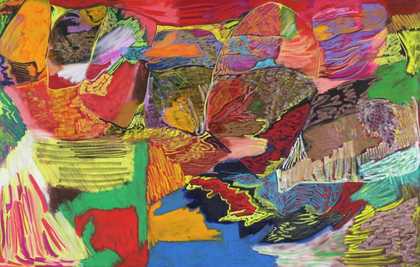
Where is it? Room 28, Main Floor, Modern and Contemporary British Art: The State We're In 2000–now.
Take a long look at this artwork. How would you describe the colours? A colour could be curious, frustrated or maybe something you can't name.
Rachel Jones is an artist who lives and works in London. Her artworks are made with oil sticks and pastels that she blends together in different ways, layering them on top of each other. Jones explores colour and how we connect it with feelings.
Do the colours and shapes in this artwork make you feel a certain way? Maybe you can say how you think the artist was feeling when she made it.
How about the title – lick your teeth, they so clutch? Clutch is slang for excellent, or an accomplishment. Does knowing the title make you view the work differently?
Watch an interview with Rachel Jones on Tate Kids

